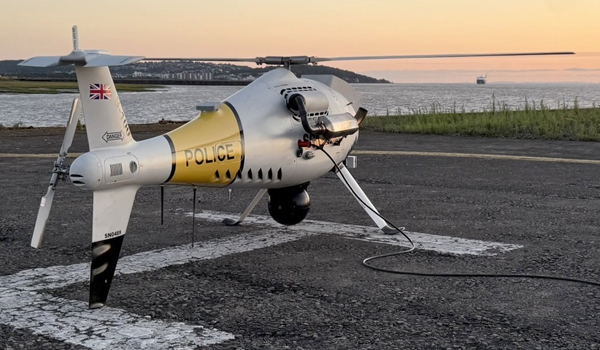NPAS begins first trials of uncrewed aircraft
The National Police Air Service (NPAS) has launched its first series of trial flights of a Beyond Visual Line of Sight (BVLOS) uncrewed aircraft system (UAS), which it says marks “a significant step in the future of police air support across England and Wales”.
Funded by the UK Home Office, these trials aim to explore if and how BVLOS UAS can complement traditional manned police helicopters and fixed-wing aircraft, enhancing the delivery of air support through greater flexibility, sustainability and cost-effectiveness.
NPAS is using a CAMCOPTER® S-100 system, supplied by the manufacturer Schiebel.
“Earlier this year, we were awarded a place in the UK Civil Aviation Authority’s (CAA) BVLOS Integration Sandbox – a controlled environment designed to safely test new aviation technologies within regulatory frameworks,” said NPAS. “This opportunity allows us to trial innovative systems while contributing to the development of future aviation policy in the UK.”
The BVLOS UAS trials form part of the NPAS Futures and Innovation Programme, which is focused on harnessing new technologies to improve operational effectiveness and environmental sustainability. It also complements the ongoing work of the National Police Chiefs’ Council in exploring the opportunities that drone technology brings to policing.
David Walters, head of Futures and Innovation at NPAS, said: “As technology advances, so too do the opportunities for police air support. This trial will test uncrewed aircraft capable of flying for up to six hours, equipped with mission systems comparable to those on our current fleet.
“If successful, this could pave the way for a highly capable and sustainable blended fleet of helicopters, aeroplanes and uncrewed aircraft.
“Our goal is to ensure the right tool is available at the right time, in the right place, to support policing across England and Wales.
“This represents an ambitious step toward a modern, innovative and best-value police aviation service, designed to meet the diverse needs of policing and communities.”
NPAS continues to work closely with the CAA and NATS, the UK’s leading provider of air traffic control services, to ensure all operations are conducted safely and in full compliance with aviation regulations.
Sophie O’Sullivan, director of Future of Flight at the CAA, said: “We’re committed to enabling the emergency services across the UK to harness cutting-edge aviation technology to do their jobs more efficiently and effectively.
“Through our support for innovative projects like the trial with NPAS, we are helping future-proof critical operations and ensuring that emergency services can safely benefit from the opportunities presented by drones and advanced air mobility.
“The data gathered from these trials will play a vital role in shaping future policies and accelerating the safe and effective integration of new technologies across the emergency services sector.”
The trials will initially take place in a CAA-approved Temporary Danger Area (TDA) to remove all risk of confliction with other aircraft.
The second phase of the trials (approximately three months later) will operate in a Temporary Reserved Area, which is going through the CAA approvals process.


